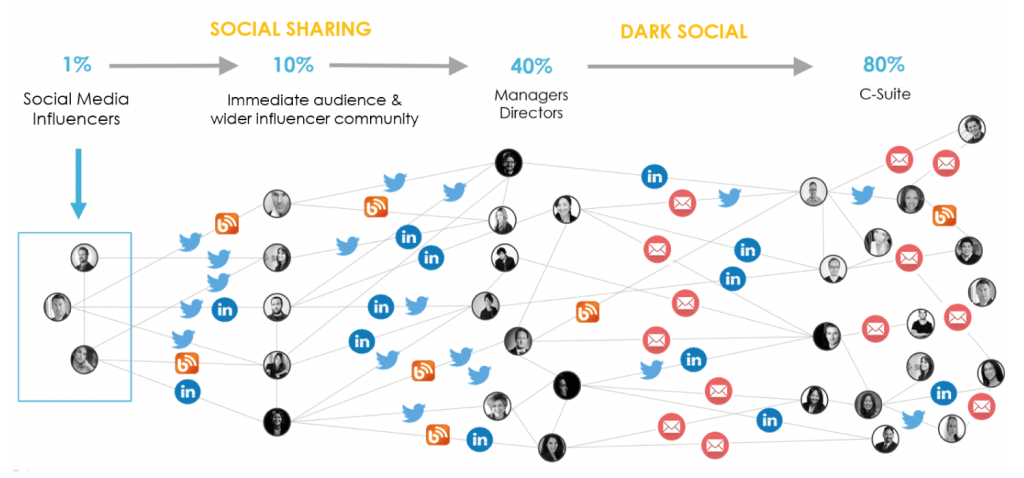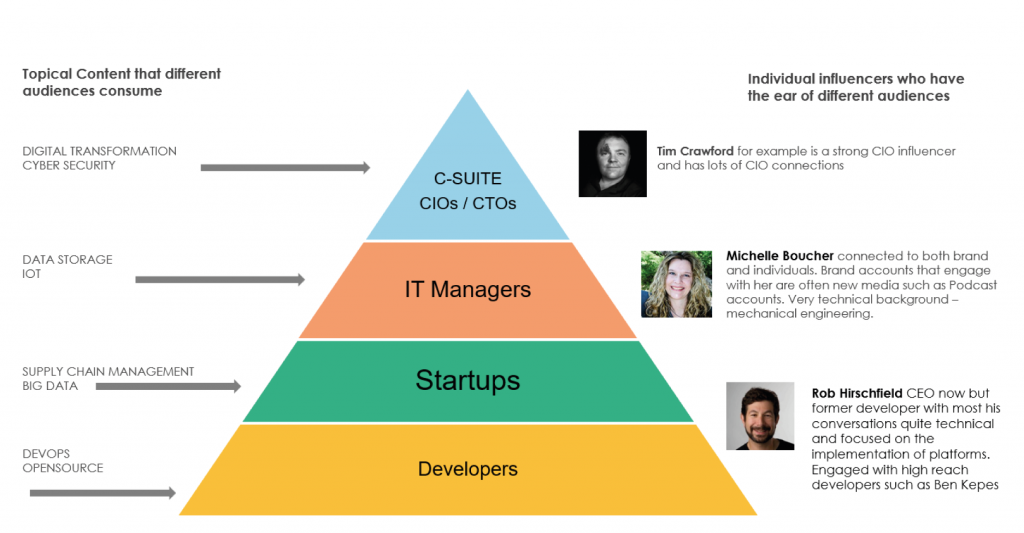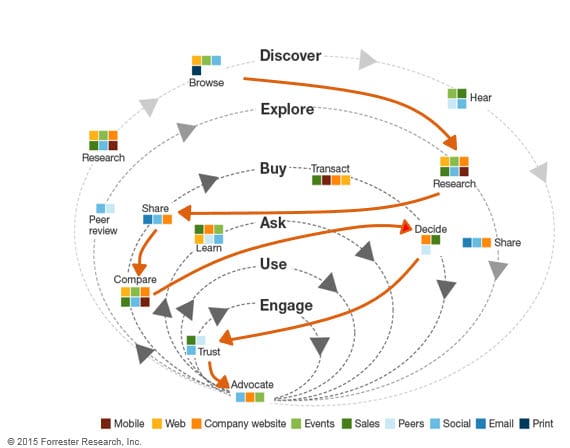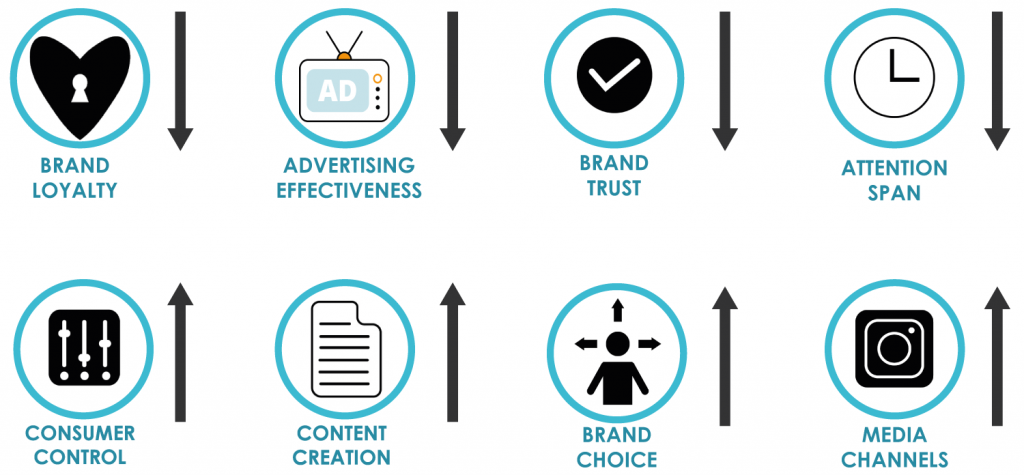Brands’ need and desire to effectively communicate with their employees has always been hot on their agenda. But the way in which brands have approached this has evolved a lot over the years. Brands have continuously looked for new and effective ways to communicate brand news, policies and information to their employees through mediums such as the intranet. But what we’re seeing a lot more, is not just the need to communicate with employees, but with the target audiences through the employees.
The most common way to reach your target audience through your employees, is to encourage your employees to get active on social media; sharing branded content, industry content and indeed writing their own content. To most, this will resemble what we commonly refer to as ’employee advocacy’. However, for employee advocacy to be truly successful, employees’ social media activity must remain authentic. Organisations must provide guidance and support to facilitate their employees, while allowing employees to maintain their tone of voice, style and genuine opinions.
We’re going to take you through exactly what employee advocacy is and the 5 main reasons why your employees should be on social media.
What is Employee Advocacy?
Employees are the heart, soul and greatest asset of an organisation – an engaged, motivated and aligned workforce is essential to create quality products, sustain high morale, deliver exceptional customer service and build positive brand reputation in the marketplace. If brands put the employee first and invest in them then, in return, brands will be rewarded by employees becoming fans of the brand and delivering better results all round.
From a brand’s perspective there are 5 main motivations behind encouraging employee social media use today, with the first two being more commonplace:
- 1. Encourage employees to share branded content to increase content reach and access new audiences.
- More effective 2-way channel to communicate with their employees than the traditional intranet.
- Increase staff retention by helping staff to develop and build their personal brands.
- Encourage employees to create their own content online to increase awareness and drive consideration in the marketplace.
- Connect employees with external industry influencers to increase engagement and influence in the marketplace offline and online.
An employee advocate is someone that can stimulate engagement and grow brand awareness among their audience through their digital media, social media or offline channels. They have an audience that follow and trust their opinion. There is also a huge opportunity for employees to create their own content and increase their overall influence in the marketplace by engaging and building relationships with assigned influencers. This is an area in which employee advocacy overlaps with influencer marketing and a concept that we explore extensively in our Employee Advocacy 2.0 guide.

Download Employee Advocacy 2.0
Why Employee Advocacy?
1. The market has changed
Regardless of which market we look at, brand choice and therefore competition for attention is increasing and providing more options to consumers; content is also in abundance and much easier for consumers to access. As stated by Buzzsumo: “If you are sticking with your content approach from three years ago, it is now 50% less effective. Our review of 100 million articles published in 2017 found that social sharing has halved since 2015”.
The rise of dark social
Something that is not spoken of enough is the concept of ‘dark social’. A large proportion of B2B employees and marketers question why they should invest time and money to post content on social media channels when they cannot see key decision makers on platforms such as Twitter or Instagram. Many of these key decision makers also have inactive LinkedIn and Facebook profiles. However, in this case, the target audience do not have to be on social media in order for the content to reach them. The B2B model below shows how the C-Suite are being influenced by employee-influencer content.

When social media influencers post content on their personal blogs, Twitter and LinkedIn accounts, their immediate audience and wider influencer community share and spread their content on the same channels. This content in turn influences predominantly mid-level decision makers such as managers and directors (C-Suite if you are lucky) who use social media and follow market influencers.
What happens next is that the mid-level decision makers or “recommenders to the C-Suite” share the content by email, text message, LinkedIn or WhatsApp for example. They also share and influence offline over the phone and even face-to-face. This social activity is called “Dark Social” as it cannot be tracked and is therefore a major challenge for marketers looking to prove a concrete ROI.
Taking this model a stage further, there are often multiple personas or target audiences for B2B marketers and they can be influenced through organic social media activity in 2 ways:
- Create topically relevant and engaging content that is shared through influencers’ social networks
- Influence and build relationships through your employees with specific influencers who have the ear of your target audience, their direct audience both offline and online
In the example below on the left-hand side, the C-Suite are more interested in Digital Transformation whereas Data Storage content is consumed by IT Managers and posts around DevOps are picked up by developers.
On the right-hand side there are 3 example influencers that each have a different target audience. Tim Crawford is a CIO advisor; Michelle’s technical background enables her to share her deep technical expertise on a peer-to-peer level with IT Managers and Rob is a CEO/developer who can influence both start-ups and developers as he has walked the walk and is trusted in his field. The exciting reality is that B2B marketers can now influence up to 80% of their target market through creating content on social and building relationships with influencers.

Mapping your market to understand where your key decision makers are and who they’re influenced (and then who their influencers are influenced by) by is integral to understand just how you can influence them through your employees, both online and offline.
 “Employee advocates are the new authentic marketing channel for brands. By sharing helpful content that engages communities, employee advocates encourage others to share and amplify their brand’s message, leading to increased social chatter, web traffic and sales.”
“Employee advocates are the new authentic marketing channel for brands. By sharing helpful content that engages communities, employee advocates encourage others to share and amplify their brand’s message, leading to increased social chatter, web traffic and sales.”
Cheryl Burgess, CEO, Blue Focus Marketing
2. Traditional Activities are no longer as Effective
Gone are the days when marketing would seek out leads and then hand them over to sales to negotiate the deal. Social Media has been a game changer for sales and marketing, who now need to work together across all levels of the sales funnel.
Around 65% of these new, more proactive buyers felt that vendor content had an impact on their final buying decision. An organization’s ability to create a connected, inclusive employee advocacy program, where all employees can contribute to brand reputation, keep its products front-of-mind, and showcase themselves as experts in their field, is critical to its future marketing and sales success.
When sales, marketing and social activity is all focused on ‘inbound’ i.e. attracting leads through an Integrated Model, silos are removed to leave a more connected organization.
Inbound leads are also higher quality; with Deloitte reporting that customers referred by advocates have a 37% higher retention rate. Compare this to the less targeted, traditional, outbound marketing approach. A hit-and-miss marketing technique made especially difficult since the recent implementation of the GDPR. Often little more than ‘cold’ email campaigns that were not always well received.
This is perhaps unsurprising given that we know that 75% of B2B buyers use social media to support purchase decisions and, according to LinkedIn, 90% of B2B buyers are more likely to engage with sales professionals who are viewed as thought leaders in their industry.
Because advocacy carries greater trust and credibility, it will inevitably increase trust and authenticity associated with the brand. According to LinkedIn, employee-shared content is regarded as being three times more authentic and therefore typically sees a click-through rate that is twice as high as when the corporate mouthpiece shares the same data.
We are also seeing lots of data on the declining effectiveness of traditional advertising. Now this isn’t to say that advertising is a dated tactic that marketers should move on from – this is far from the truth. Advertising, when appropriate and done well is extremely effective, but it isn’t always enough. Buyer journeys tend to be longer and far more complex now, of which advertising often remains integral to, but merely works to intrigue the buyer and prompt them to do more research. We will discuss the modern buyer journey later in this blog.
 “Traditional marketing is failing to achieve the cut-through it has seen; people are gravitating to ad-free environments; trust, transparency and authenticity are a major public concern; and technological innovation is transforming the landscape.”
“Traditional marketing is failing to achieve the cut-through it has seen; people are gravitating to ad-free environments; trust, transparency and authenticity are a major public concern; and technological innovation is transforming the landscape.”
Caroline Jory, Engagement Director, Qubist
 “Consumers are disappointed by brands. Trust in brands is lower than ever and the flipside of that is just as important, that people are trusted more. The reasons people are trusted more than advertising is that there is no financial stake in the outcome.”
“Consumers are disappointed by brands. Trust in brands is lower than ever and the flipside of that is just as important, that people are trusted more. The reasons people are trusted more than advertising is that there is no financial stake in the outcome.”
Jay Baer, Founder at Convince & Convert
3. People buy from people, not logos
As we’re all well aware of by now, consumers are trusting brands less and people more. And when we say people, we’re referring to friends, family, colleagues, influencers and indeed, employees.
Ultimately, people – especially buyers – trust the opinions and reviews of individuals far more than those of an entity or brand. Edelman’s Trust Barometer holds 2018 up as the year of the ‘battle for truth’ and, what seems certain is, there has never been more importance placed on truth and authenticity. Edelman’s 2018 report states that nearly 7 in 10 respondents highlighted ‘building trust’ as the number one priority for CEOs; ahead of high-quality products and services.
For the employee voice to deliver this credibility and authenticity, and for trust to be conveyed, the organization must be well connected both in terms of the internal sharing and understanding of information and its links with the external audience. Employees must also maintain their content style, tone of voice and integrity with their audiences.
 “Brands have been using digital and social media to distance themselves from the consumer, asking them to sign up to email lists and to do things that are very programmatic and distant from the consumer. It is very hard to build trust in that way of doing business. But, brands can now use digital if they empower employees and influencers correctly to shrink that distance back and regain that trust that has been lost over the last 8 or 9 years.”
“Brands have been using digital and social media to distance themselves from the consumer, asking them to sign up to email lists and to do things that are very programmatic and distant from the consumer. It is very hard to build trust in that way of doing business. But, brands can now use digital if they empower employees and influencers correctly to shrink that distance back and regain that trust that has been lost over the last 8 or 9 years.”
Brian Fanzo, Founder & CEO at iSocialFanz
Employees are generally perceived as more credible content sharers and they have loyal networks which give them both a greater reach and greater influence. It is a positive investment for brands to put their employees in front of their logo.
 “In a world where buyers trust baristas and used car salesmen more than marketers, brands desperate to find effective ways to engage with new customers are beginning to realize the solution is right in front of them: employees. Research has shown customers trust employees more than ads or formal marketing messages. Inspiring employee advocacy means brands can enlist those closest to knowledge of the company’s solutions to make genuine, authentic recommendations that people want to hear.”
“In a world where buyers trust baristas and used car salesmen more than marketers, brands desperate to find effective ways to engage with new customers are beginning to realize the solution is right in front of them: employees. Research has shown customers trust employees more than ads or formal marketing messages. Inspiring employee advocacy means brands can enlist those closest to knowledge of the company’s solutions to make genuine, authentic recommendations that people want to hear.”
Lee Odden, CEO at TopRank Marketing
With the right foundations in place, brands can begin to build credibility with buyers. Employee advocates become known as experts in their field and can remain ‘front-of-mind’ with their social networks. This positions them to deliver information and advice to prospective buyers as and when – or even in advance of when – it is needed.
Brands being able to nurture relationships in this way and guide the buyer to their products or services at as early a stage as possible is the new differentiator. Success does not stop during the relationship-building stage: because of the improved perception and greater credibility of posts by individuals over brands, the content shared by employees receives, on average, 8 x more engagement and is then re-shared 25 x more frequently than the same content shared by official brand channels.
Further along the process, a fully-embedded and successful employee advocacy program becomes a self-fulfilling prophecy. Employees can better understand their business; higher quality information and knowledge is shared; individuals associated with the brand command more credibility with their audience; confidence and engagement levels increase; thought leadership contributions grow; the brand is commonly associated with expertise in the field, remains front-of-mind for buyers and is differentiated from competitors.
 “Even though people trust people more than they trust brands– which is true and proven in copious studies – this often does not include the C-suite. Of course they are going to sing the company’s praises, that is their job. But when you get an employee that is an enthusiast, who becomes an influencer internally and externally – they can have a lot of influence.”
“Even though people trust people more than they trust brands– which is true and proven in copious studies – this often does not include the C-suite. Of course they are going to sing the company’s praises, that is their job. But when you get an employee that is an enthusiast, who becomes an influencer internally and externally – they can have a lot of influence.”
Tom Augenthaler, The Influence Marketer
4. The Modern Buyer Journey
With all the above said, the modern buyer journey is changing and becoming increasingly more digital with many more touch points both before and after the purchase takes place. So, brands must work harder to remain a part of the journey.
These changes are due to changing attitudes and behaviors prompted by advances in technology. With the decreasing trust towards traditional advertising and logos, consumers are turning to the internet and people. Before they make a purchase, they are asking their friends and family for advice and recommendations; they are venturing online and seeking tutorials & unboxing videos from YouTube Influencers & bloggers and sites like Amazon, Trip Advisor & Trustpilot.com with transparent ratings and customer reviews.
At every stage of the journey customers are exposed to content, opinions and experiences of other people just like them; no longer is the only information from the brand themselves, but it is from the brand and everyone else. Social media can be the making, or the breaking of a brand.
 “It is becoming more commonplace for today’s buyers to begin their journey online, namely among social networks. Whether it is as close-knit as asking a specific group of friends for recommendations, or broadcasting on social for the public opinion, it is imperative that brands have an opportunity to be a part of the conversation. Employee Advocacy helps drive this journey.”
“It is becoming more commonplace for today’s buyers to begin their journey online, namely among social networks. Whether it is as close-knit as asking a specific group of friends for recommendations, or broadcasting on social for the public opinion, it is imperative that brands have an opportunity to be a part of the conversation. Employee Advocacy helps drive this journey.”
Eric Fuessel, Senior Account Executive, EveryoneSocial

Let us use shopping as an example that everyone can easily apply to their own lives. Before the advent of social media and online shopping, consumers would head straight into store with the intent to buy and make a purchase there and then. Sure, they may ask the in-store sales rep for help and maybe seek recommendations from their friends and family beforehand (influence has always existed!), but it is a relatively quick journey and limited to that store’s availability.
Compare this to a journey today on Amazon – not only are customers able to browse multiple options at different price points from different brands to compare at their leisure, but they’re are able to view a top-line rating out of 5 and detailed customer reviews. They can also take their research beyond Amazon’s site to easily access blog posts and YouTube videos from influencers and experts that have tried and tested the products for them to further validate their decision.
Customers can make their purchase with confidence and minimal risk because they have conducted their research before-hand. And this is not just applicable to B2C, but it is mirrored in B2B too. As a consumer, this is great; as a business, this can be a nightmare if not leveraged correctly.
Thanks to the democratization of content and technology advancements (namely smart phones), consumers have more control, are savvier than ever and already have a pretty good idea of what they want before they even speak to a sales rep.
Search engines and social media algorithms are also getting smarter too and only putting content that the user is likely to find useful in front of them. Facebook is a great example of this, whereby they altered their algorithm at the beginning of 2018 to favor content from their Facebook friends, over liked company Facebook pages.
Brands cannot just create great content that they are confident their target audience will find useful, they must be far more strategic and work around the smarter algorithms and decreasing trust in brands and advertising to get this content in front of their target audience, before their competitors do.
 “The democratization of information, communication and influence leads to more players in the room and therefore each one gets heard a little bit less. But for influencers that are YouTubers or Instagrammers – they started out with zero, so they are acquiring new market share.”
“The democratization of information, communication and influence leads to more players in the room and therefore each one gets heard a little bit less. But for influencers that are YouTubers or Instagrammers – they started out with zero, so they are acquiring new market share.”
Neal Schaffer, CEO, PDCA Social
This is where employee advocacy (including social selling) and influencer marketing comes in to play – all three are tied together by people and the influence that they have. The main benefits to brands are:
- Increase reach – on average, employees collectively have 10 x the reach compared to brand handles.
- Increase engagement – not only do employees have larger audiences, but they are more engaged too. On average, content shared by employees receives 8 x more engagement than content shared on brand channels and is 25 x more likely to be re-shared by their audience.
- Increase brand awareness – 65% of brands report increased brand recognition from their employee advocacy program.
- Influence the buyer journey – It is now more important than ever to focus more time and attention on the earlier stages of the buyer journey as 85% of customers seek out trusted expert content when considering a purchase and 84% of C and VP level buyers use social media in their decision-making process. Because of this, 70% of the B2B buyer’s journey is complete before they even reach out to sales.
- Increase lead conversion – 84% of B2B buyers start the purchasing process with a referral and leads generated through employees have been found to convert 7 x more than any other lead gen source. Social selling also offers a great solution to the decreasing effectiveness of the cold call.
- Improve brand perception – engaging and associating with industry influencers is a very effective method of changing and shaping brand perception.
- Increase brand trust and confidence – people are much easier to trust than logos. The humanization of your brand by your employees being the face of your brand will enable customers to trust and feel a connection with your brand.
- Improve staff retention – increase job satisfaction and create a rewarding corporate culture.
- Attract new talent – gain more visibility as a desirable place to work.
 “Our organic reach would max at about 63,000 if everyone saw everything we posted. If just 10% of our 4,500 UK workforce shares content, the number jumps to a potential reach of 380,000. Extrapolate that by every piece of content and the opportunity stacks up.”
“Our organic reach would max at about 63,000 if everyone saw everything we posted. If just 10% of our 4,500 UK workforce shares content, the number jumps to a potential reach of 380,000. Extrapolate that by every piece of content and the opportunity stacks up.”
Keith Lewis, UK Social Media & Social Business manger
“The buyer journey is nothing more than a series of questions your buyers are asking. The best source of the answers to those questions are the folks inside your company who live and breath your products, solutions, and services. Employee advocacy allows you to become the sought after expert in solving your potential customer challenges.”
Michael Brenner, CEO at Marketing Insider Group
5. Activate your Millennials’ Voices
Firstly, millennials will represent 75% of the workforce by 2030, according to the U.S. Bureau of Labor Statistics.
Millennials are vocally opinionated and are not afraid to voice those opinions on their social profiles with their audiences. Millennials also like to feel as though they are contributing to the wider success of an organization, so being a part of an employee advocacy program will be highly appealing to them.
In a study conducted by Hinge Research Institute, they found that millennials came out on top for recognizing the benefits of employee advocacy compared to Baby Boomers and Gen X: 46% of millennials saw employee advocacy as an opportunity to develop skills high in demand; 39.4% access to more job opportunities and 38% differentiation from peers. This level of enthusiasm and excitement is just the mindset that brands want, as it can easily be reflected in their advocacy of the brand.
Millennials are also extremely experiential, so they see the value that employee advocacy can bring to the customer experience, as 75% of millennials are willing to spend money on an experience over a product. They are savvy, on social media and keen to network and build their profiles, so selling in the concept of an employee advocacy program will not be such a challenging feat compared to the older generations within the workforce. In fact, an integrated employee advocacy and influencer marketing program will make the opportunity appear more worthwhile to them thanks to the prospect of improving their personal brand.
Brands starting with their millennials as part of a pilot program is a great way to get and demonstrate early success to on-board more employee advocates.
 “The difference with millennials is that they are not afraid to voice their opinion and say that they want to be acknowledged. I also think it comes down to transparency – millennials do not want to know that they got 23 tweets, they truly want to know that they are helping the business.”
“The difference with millennials is that they are not afraid to voice their opinion and say that they want to be acknowledged. I also think it comes down to transparency – millennials do not want to know that they got 23 tweets, they truly want to know that they are helping the business.”
Brian Fanzo, Founder & CEO, iSocialFanz
If you would like to download the full Employee Advocacy 2.0 guide to integrate employees into your influencer marketing program to achieve maximum success, click the link below.

Download Employee Advocacy 2.0
TAGS
Employee Advocacy 2.0
Leveraging influence to drive a connected organisation and employee-led buyer journey
Download this free report to learn how to integrate Influencer Marketing, Employee Advocacy and Social Selling into one advocacy program.


